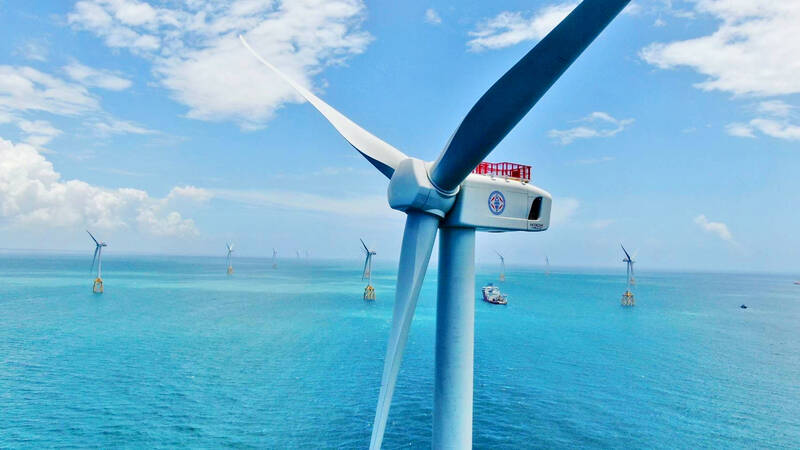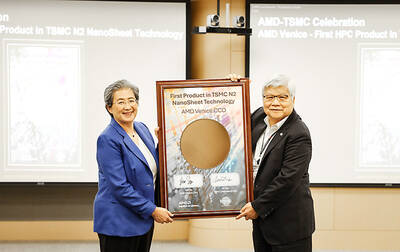Japanese companies are dropping out of offshore wind projects in Taiwan, one of fastest-growing markets for the technology, as rising costs and worsening delays plunge the industry into deeper trouble worldwide.
Oil refiner Eneos Holdings Inc last week said that it might exit the Yunlin Offshore Wind Project (允能雲林離岸風廠) after regional utility Shikoku Electric Power Co decided to pull out of the same project due to delays threatening its profitability.
Electricity generator JERA Co announced that it completed the sale of its stake in Formosa 3, another Taiwanese offshore wind project, in June.

Photo courtesy of Taiwan Power Co
“The withdrawal of companies indicate that the attractive proposition of Taiwan’s offshore wind is diminishing, which might affect investor confidence in the sector,” said Diao Chenyuan (刁晨元), managing consultant for power and renewables research at Wood Mackenzie Ltd.
However, Japan’s Mitsui & Co has decided to continue investing in building offshore wind farm in Taiwan, teaming up with Canada’s Northland Power Inc, the Ministry of Economic Affairs said yesterday.
Spanish power company Iberdrola group, Blue Float Energy Co, France’s EDF group and Floatation Energy are also continuing with their plans to develop offshore wind farms, the ministry said.
Taiwan’s wind farms are part of a plan to increase the ratio of electricity coming from renewables to 20 percent by 2025, from 8 percent last year.
The nation aims to have 5.7 gigawatts of offshore wind capacity by then, compared with 2.1GW now.
Taiwan is also looking to increase its use of natural gas, cut coal and eliminate nuclear power, but is falling behind schedule on its targets.
Fewer players in the market reduces competition and leads to undersubscription in tenders, and could jeopardize Taiwan’s targets, Diao said.
The troubles in Taiwan’s wind industry compound a crisis that has already hit other parts of the world, as the aftereffects of the COVID-19 pandemic push up the cost of labor and borrowing.
While many businesses are able to offset cost changes by raising prices, many wind developments find themselves locked into contracts to sell power at rates set years ago.
Denmark’s Orsted A/S this week withdrew from a partnership developing offshore wind in Norway due to rising costs, while BP PLC and Norway’s Equinor ASA recently took large impairments on projects.
US-based public utility Eversource Energy also incurred a US$331 million after-tax impairment charge in the second quarter for its offshore wind operations.
In Taiwan, rigid requirements mandating that developers procure 60 percent of their equipment from local manufacturers have made projects even more expensive, sometimes doubling costs.
The rules could lead to a sharp rise in offshore tariffs, saddling ratepayers with higher prices and bringing delays in installations, BloombergNEF Analyst Leo Wang said in a report this month.
Less experienced suppliers in new offshore wind markets also often offer products that are more expensive than their international peers and of lower quality, he said.
Additional reporting by Lisa Wang

UNCERTAINTY: Innolux activated a stringent supply chain management mechanism, as it did during the COVID-19 pandemic, to ensure optimal inventory levels for customers Flat-panel display makers AUO Corp (友達) and Innolux Corp (群創) yesterday said that about 12 to 20 percent of their display business is at risk of potential US tariffs and that they would relocate production or shipment destinations to mitigate the levies’ effects. US tariffs would have a direct impact of US$200 million on AUO’s revenue, company chairman Paul Peng (彭雙浪) told reporters on the sidelines of the Touch Taiwan trade show in Taipei yesterday. That would make up about 12 percent of the company’s overall revenue. To cope with the tariff uncertainty, AUO plans to allocate its production to manufacturing facilities in

TAKING STOCK: A Taiwanese cookware firm in Vietnam urged customers to assess inventory or place orders early so shipments can reach the US while tariffs are paused Taiwanese businesses in Vietnam are exploring alternatives after the White House imposed a 46 percent import duty on Vietnamese goods, following US President Donald Trump’s announcement of “reciprocal” tariffs on the US’ trading partners. Lo Shih-liang (羅世良), chairman of Brico Industry Co (裕茂工業), a Taiwanese company that manufactures cast iron cookware and stove components in Vietnam, said that more than 40 percent of his business was tied to the US market, describing the constant US policy shifts as an emotional roller coaster. “I work during the day and stay up all night watching the news. I’ve been following US news until 3am

COLLABORATION: Given Taiwan’s key position in global supply chains, the US firm is discussing strategies with local partners and clients to deal with global uncertainties Advanced Micro Devices Inc (AMD) yesterday said it is meeting with local ecosystem partners, including Taiwan Semiconductor Manufacturing Co (TSMC, 台積電), to discuss strategies, including long-term manufacturing, to navigate uncertainties such as US tariffs, as Taiwan occupies an important position in global supply chains. AMD chief executive officer Lisa Su (蘇姿丰) told reporters that Taiwan is an important part of the chip designer’s ecosystem and she is discussing with partners and customers in Taiwan to forge strong collaborations on different areas during this critical period. AMD has just become the first artificial-intelligence (AI) server chip customer of TSMC to utilize its advanced

Six years ago, LVMH’s billionaire CEO Bernard Arnault and US President Donald Trump cut the blue ribbon on a factory in rural Texas that would make designer handbags for Louis Vuitton, one of the world’s best-known luxury brands. However, since the high-profile opening, the factory has faced a host of problems limiting production, 11 former Louis Vuitton employees said. The site has consistently ranked among the worst-performing for Louis Vuitton globally, “significantly” underperforming other facilities, said three former Louis Vuitton workers and a senior industry source, who cited internal rankings shared with staff. The plant’s problems — which have not